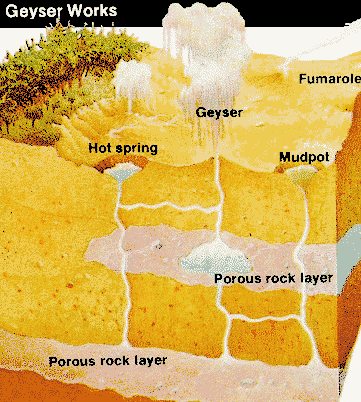

A geyser is a special type of hot spring that erupts periodically. For both geysers and hot springs, groundwater circulating at depth becomes heated by the hot rock below and moves by convection, toward the surface. As it rises, it follows zones of weakness that become channels leading upward. In a geyser, these channels have constrictions which prevent the water from circulating freely to the surface where the heat would escape. The water becomes progressively hotter at depth, exceeding the surface boiling point (199° F., 93° C). Yet it will not vaporize in the geyser tube at this temperature because of the greatly increased pressure exerted by the enormous weight of the overlying water.
Bubbling upward, steam expands as it nears the top of the water column until the bubbles are too large and numerous to pass freely through the tight spots. At a critical point, the confined bubbles actually lift the water above, causing the geyser to overflow. This decreases pressure on the system and violent boiling results. A tremendous volume of steam is instantly produced, forcing water explosively out of the vent in a superheated mass.
The eruption begins. In an eruption, water is expelled faster than it can enter the geysers plumbing system at depth. As the eruption continues, the heat and pressure gradually decrease. The eruption stops when the water resevoir is exhausted or when the gas bubbles diminish enough to be able to rise through the water column without ejecting it. Fountain type geysers generally shoot water out in various directions, most often from a pool. Cone type geysers generally erupt in a narrow jet of water, usually from a cone or nozzle-like formation.
Old Faithful erupts more frequently than any of the other big geysers, although it is not the largest or most regular geyser in the park. Its average interval between eruptions is about 75 minutes, varying from 45 - 105 minutes. An eruption lasts 1½ to 5 minutes, expels 3,700 - 8,400 gallons (14,000 - 32,000 liters) of boiling water and reaches a height of 100 - 190 ft. (30 - 55 m). It was named for its consistent performance by the members of the Washburn Expedition of 1870. Although its average interval has lengthened over the years (due to earthquakes and vandalism), Old Faithful is still as spectacular as it was a century ago.
Anemone Geyser beautifully displays the stages of a typical eruption. The pool fills, it overflows, and large bubbles rise to the surface causing splashing. Suddenly the bubbles are of explosive force, throwing the water into eruptions of 10 feet or more. The water then drains back into the vent with a gurgling sound. The cycle is repeated regularly every 7 - 10 minutes.
This material is abstracted from brochures distributed by The Yellowstone Association for Natural Science, History & Education, Inc.